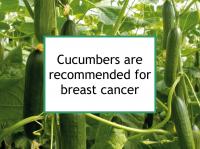Like pumpkins, zucchini and other types of squash, cucumbers (Cucumis sativus) belong to the cucurbitaceae (gourd) family. Cucumbers have a high water content and are low in calories. Cucumbers are a relatively good source of chemopreventive cucurbitacins. Cucumbers also contain some lupeol, lutein, molybdenum and vitamin K.
Cucumbers have been shown to have some antioxidant activities and contain numerous phytochemicals, but the levels are low compared to those of intensely colored fruits and vegetables. Cucumber consumption may help reduce cholesterol. Cucumber fruit and leaf extracts have been found to be useful in soothing the skin and to treat inflammatory skin conditions such as rosacea. Consumption of cucumbers has been found to be associated with lower risk of lung cancer among tin miners in China.
Breast cancer-related effects of eating cucumbers
A Korean case-control study comparing the diets of breast cancer patients with a healthy control group of women found that the breast cancer patients consumed a significantly lower quantity of vegetables, including cucumbers, than the control group. A Greek study also found that women with breast cancer consumed significantly fewer cucumbers than those without breast cancer. A Swiss study also reported that consumption of cucumbers, among other fruits and vegetables, was associated with significant protection against breast cancer.
Cucurbitacins
Cucurbitacin B, cucurbitacin D and cucurbitacin E are bitter compounds found in modest amounts in cucumbers — cucumbers have been cultivated to minimize their cucurbitacin content and the associated bitterness and toxicity. Cucumber skin is a far better source of cucurbitacins than the flesh. Cucumbers also incorporate cucurbitacin C, for which little research is available.
Cucurbitacin B
Cucurbitacin B has been shown to inhibit the growth and proliferation of hormone receptor positive (ER+/PR+), HER2-positive (HER2+), and triple negative (ER-/PR-/HER2-) cells, as well as cells with harmful BRCA1 mutations. A tiny amount of cucurbitacin B was found to halve tumor volume without harming the animals in an experiment using a mouse model of triple negative breast cancer.
A low dose of cucurbitacin B was also shown to enhance the treatment effects of docetaxel in another mouse model of triple negative breast cancer, without toxicity to the animals.
Cucurbitacin D
One study reported that cucurbitacin D has similar effects to the chemotherapy drug doxorubicin in ER+/PR+, HER2+ and triple negative breast cancer cells. Another study demonstrated that co-administration of cucurbitacin D enhanced the treatment effects of doxorubicin in doxorubicin-resistant ER+/PR+ breast cancer cells. Cucurbitacin D has also been shown to improve the therapeutic efficacy of docetaxel.
Cucurbitacin E
Cucurbitacin E, the most common cucurbitacin in foods, is found in modest amounts in pumpkins, watermelon and zucchini, as well as cucumbers. Cucurbitacin E has been shown to induce cell cycle arrest and apoptosis in ER+/PR+ and triple negative breast cancer cells. In addition, cucurbitacin E has been demonstrated to reduce metastasis by inhibiting cell migration and invasion in a mouse model of triple negative breast cancer.
There is some evidence that cucurbitacin E can improve treatment of multidrug-resistant breast cancer cells by targeting EGFR and silencing its downstream signaling paths. In fact, cucurbitacin E has been reported to increase the treatment effects of doxorubicin in ovarian cancer cells.
Bitter Cucurbitaceae
Colocynth (Citrullus colocynthis), also known as bitter apple or bitter cucumber, and bitter Hawkesbury watermelon (Citrullus lanatus), both of which are related to watermelon, have a much higher fraction of cucurbitacins than cucumbers or any other food. High-cucurbitacin extracts of these inedible fruits are sometimes sold as herbal remedies, including for cancer. However, while chemotherapy based on cucurbitacins may eventually be developed, these are toxic chemicals whose safety profiles and appropriate dosages have not been determined. Cucurbitacin supplements are not recommended.
Additional comments
Cucumbers (whether store bought or home grown) with an unusually bitter taste, which indicates that they may have an abnormally high level of cucurbitacins, should be avoided.
Organically grown cucumbers are preferable
Organic cucumbers are preferable to conventionally grown cucumbers. Cucumber skin is the most nutritious part of cucumbers (followed by the seeds), but conventional cucumbers normally are coated with wax that may be petroleum-based and can trap pesticide residue and other contaminants. Therefore, conventionally grown cucumbers should always be peeled, which eliminates most of the cucurbitacins. Also note that non-organic greenhouse cucumbers were found to incorporate unacceptably high levels of cadmium, lead, and chromium in one study.
Pickles have high salt content
Pickling cucumbers and gherkins also incorporate some cucurbitacins. However, the sodium content of commercial dill pickles, sweet pickles, bread and butter pickles, pickle relish and pickled gherkins can be high.
Persian and English cucumbers have low cucurbitacin content
Burpless cucumbers, such as Persian and English cucumbers, have been bred to have lower levels of cucurbitacins than common cucumbers.
Sources of information provided in this webpage
The information above, which is updated continually as new research becomes available, has been developed based solely on the results of academic studies. Clicking on any of the underlined terms will take you to its tag or webpage, which contain more extensive information.
Below are links to 20 recent studies concerning this food and its components. For a more complete list of studies, please click on cucumber.
